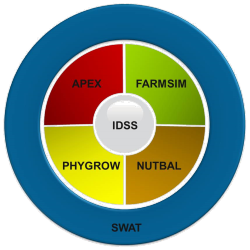
IDSS provides an integrated approach that links production, economic, and environmental consequences of the introduction of new technology, policy, and training for decision makers in agriculture at multiple temporal and spatial scales.
IDSS is used in the Feed the Future Innovation Lab for Small-Scale Irrigation (ILSSI), a project of the U.S. Government’s Feed the Future Initiative. ILSSI is a five-year project in Ethiopia, Ghana and Tanzania aimed at benefiting the region’s farmers by improving effective use of scarce water supplies through interventions in small-scale irrigation.

The Concept
The Integrated Decision Support System (IDSS) comprises a suite of previously validated spatially explicit models and databases that have been extensively applied in both U.S. and international settings.

IDSS was developed between key political leaders in the Government of Mali, the Institute of Rural Economy, the Institut du Sahel (INSAH), Food & Agriculture Organization (FAO), and Texas A&M to conduct a pilot study in Mali. Their goal was to further develop and evaluate the suite of previously developed models for their use in the areas of food security and natural resource management in Mali with the expectation that they may be applied with minimal modification for use in other West African countries. It provides an integrated approach that links production, economic, and environmental consequences of the introduction of new technology, policy, and training for decision makers in agriculture at multiple temporal and spatial scales.
The IDSS is designed to inform ex ante strategic decisions for investments that concurrently lead to sustainable increases in agricultural productivity, improved management of soil and water resources, and improved family nutrition and livelihoods. The component models of the IDSS are highly interactive, providing the ex ante ability to evaluate and select promising options for production systems at specific sites, regions, and watersheds. Using the same IDSS, the results of subsequent results of research or policy options derived from development or demonstrations can be modeled to predict quantitative outcomes for consideration by government or private sector investors.
Model Components
FARMSIM – A Farm Income & Nutrition Simulator for Families
FARMSIM is a simulation model used for projecting the probable economic and nutritional impacts of alternative technologies, farming systems, livestock management programs, marketing arrangements, crop mixes, risk management schemes, and environmental remediation programs on a representative crop/livestock farm. Model hosted and supported by the Agricultural and Food Policy Center @ Texas A&M University.
NUTBAL – Animal Performance Report
NUTBAL assesses crude protein and net energy status of livestock based on nutrient profile of animal’s diet relative to requirements determined by genetic potential for maintenance, growth, fertility and lactation, and local environmental conditions to generate least cost feeding solutions for meeting performance goals. Decision aide is hosted and supported by the Center for Natural Resources Information Technology @ Blackland Research & Extension Center.
SWAT – A Soil & Water Assessment Tool
SWAT is a biophysical simulation model that operates on a daily time step used to quantify the impacts of land management practices on stream flows and water quality in large complex watersheds or river basins. It uses geographic information systems to manage input and output data and is sensitive to weather, topography, soils, land use/land cover, and agricultural management practices. Model is hosted and supported by USDA Agricultural Research Service Grassland, Soil, and Water Research Laboratory.
APEX – Crop & Land Management Simulation Model
APEX is a biophysical simulation model used to evaluate crop management technologies and decisions that affect agricultural production and environmental sustainability at the scales of individual fields, whole farms, or small watersheds. Model hosted and supported by Texas A&M AgriLife Research @ Blackland Research & Extension Center.
PHYGROW – Grazing & Range Land Assessment Model
PHYGROW is a phytomass growth model used to determine the effects of variations in landscapes, animal populations (conditions, demand, timing), and weather and their impacts on carrying capacity, hydrology, and stability of forage production. Model is hosted and supported by the Center for Natural Resources Information Technology @ Blackland Research & Extension Center.
Real-World Applications
- Provide common modeling environment for ex ante analyses to inform investment decisions, evaluate progress during project implementation, and forecast integrated impact from interventions.
- Identify optimum outcomes for situations which require trade-offs among production, environmental and economic benefits and costs.
- Hydrologists can anticipate how water harvesting for irrigation will affect stream flows and water quality indicators (e.g., suspended solids, ortho-phosphate, biological oxygen demand).
- Soil scientists can anticipate how alternative cropping systems affect indicators of soil fertility (e.g., topsoil pH, organic matter contents, extractable phosphorus).
- Agronomists can anticipate additional nitrogen fertilizer required to take advantage of irrigation or the increased yield potential of an improved variety.
- Human nutritionists can anticipate the impacts of interventions (such as small-scale irrigation to grow green and yellow vegetables) during the dry season on family nutrition.
- Economists can anticipate impacts of increased investments in additional land, fertilizer, seed, and/or irrigation on the probability of farm solvency over the next five years.
- Government officials concerned about floods and sedimentation of rivers, lakes, and irrigation canals can anticipate impacts of check dams on tributaries supporting small scale irrigation projects.
- Government policy makers can anticipate impacts from subsidizing costs of fertilizers, seeds, and other inputs on family nutrition and income from sales of agricultural products.
Reports
- Demonstration of the Integrated Decision Support System (IDSS) for Evaluation of New Farming Technologies at Village and Watershed Levels In Ethiopia – Pilot Report, May 2013
- Interim Report: Pilot Study of the Global Decision Support System – Phase II – Results of Presentations and Consultations, Addis Ababa, Ethiopia, April 12-20, 2013
- Relationships between the Global Decision Support System and Regional Projects – Paper presented to SANREM CRSP Research Scientific Synthesis Conference, 2001
- Impact Methods to Predict & Assess Contributions of Technology (IMPACT) – Final Report, 2000
- Development and Evaluation of Models and Methods to Improve the Assessment of Status and Estimate the Economic and Environmental Impact of Options to Enhance Food Security – Volume 1 Workshop Report, 1999
